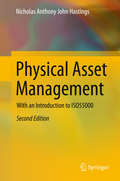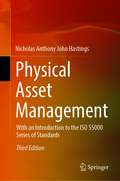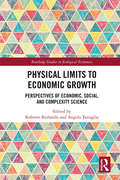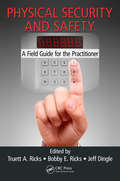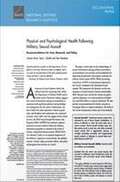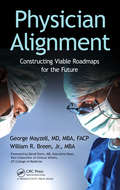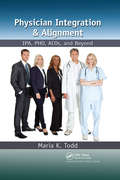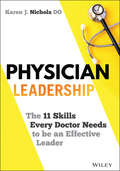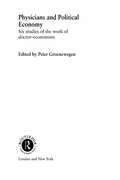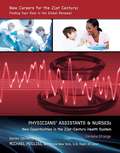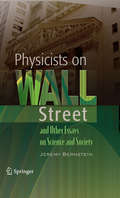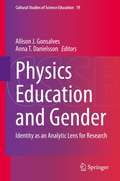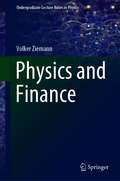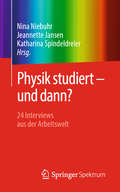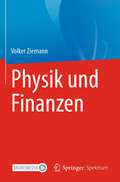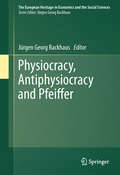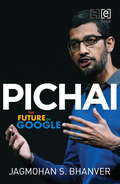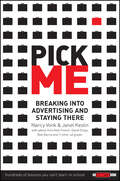- Table View
- List View
Physical Asset Management
by Nicholas Anthony John HastingsSignificantly extended from the first edition and published in response to the new international standard ISO55000, this book on physical asset management (2nd Ed. ) presents a systematic approach to the management of physical assets from concept to disposal. It introduces the general principles of physical asset management and covers all stages of the asset management process, including initial business appraisal, identification of fixed asset needs, capability gap analysis, financial evaluation, logistic support analysis, life cycle costing, management of in-service assets, maintenance strategy, outsourcing, cost-benefit analysis, disposal and renewal. Physical asset management is the management of fixed assets such as equipment, plant, buildings and infrastructure. Features include: *Suitable for university courses and builds on first edition to provide further analytical material *Aligned with the international asset management standard ISO55000 *Provides a basis for the establishment of physical asset management as a professional discipline *Presents case studies, analytical techniques and numerical examples with solutions Written for practitioners and students in asset management, this textbook provides an essential foundation to the topic. It is suitable for an advanced undergraduate or postgraduate course in asset management, and also offers an ideal reference text for engineers and managers specializing in asset management, reliability, maintenance, logistics or systems engineering.
Physical Asset Management: With an Introduction to the ISO 55000 Series of Standards
by Nicholas Anthony HastingsThis book presents a systematic approach to the management of physical assets from concept to disposal, building upon the previous editions and brought up-to-date with the new international standards ISO55002 and ISO/TS50010. It introduces the general principles of physical asset management and covers all stages of the asset management process, including initial business appraisal, identification of physical asset needs, capability gap analysis, financial evaluation, logistic support analysis, life cycle costing, strategic asset management planning, maintenance strategy, outsourcing, cost-benefit analysis, disposal and renewal. Features include:providing a textbook for asset management courses to university level;relating closely to the ISO55000 international asset management standard series;providing a basis for the establishment of physical asset management as a professional discipline; andpresenting case studies, analytical techniques and numerical examples with solutions. Written for practitioners and students in asset management, this book provides an essential foundation to the topic. It is suitable for an advanced undergraduate or postgraduate course in asset management and also offers an ideal reference text for engineers and managers specializing in asset management, reliability, maintenance, logistics or systems engineering.
Physical Culture and Sport in Soviet Society: Propaganda, Acculturation, and Transformation in the 1920s and 1930s (Routledge Research in Sports History Series #2)
by Susan GrantFrom its very inception the Soviet state valued the merits and benefits of physical culture, which included not only sport but also health, hygiene, education, labor and defense. Physical culture propaganda was directed at the Soviet population, and even more particularly at young people, women and peasants, with the aim of transforming them into ideal citizens. By using physical culture and sport to assess social, cultural and political developments within the Soviet Union, this book provides a new addition to the historiography of the 1920s and 1930s as well as to general sports history studies.
Physical Grain Trading: Core Concepts and Real-World Scenarios (Finance for Professionals)
by Andrew McKenzie Chris DeLong Thomas MeierottoThis book offers a comprehensive exploration of essential concepts and advanced strategies in the grain industry. Authored by professionals with decades of experience in grain trading, this book introduces core concepts such as hedging, basis trading, arbitrage, and counterparty risk, making it an essential read for novices. The topics covered include storage, futures trading mechanics, and the path of grain from farm to end-user. Unlike other resources, this book goes beyond introductory concepts, addressing real-world scenarios and advanced strategies in detail. The methodology employed in crafting this guide combines practical experience with academic rigor, ensuring that readers gain actionable knowledge. The book covers a broad range of topics, and its impact is profound, bridging the gap between theory and practice and empowering market participants to make informed decisions. This book contributes significantly to both research and practice, offering a holistic understanding of the physical grain trade and its broader market implications. It is intended to be used primarily by early-career practitioners and as a comprehensive text for University commodity risk management courses.
Physical Limits to Economic Growth: Perspectives of Economic, Social, and Complexity Science (Routledge Studies in Ecological Economics)
by Angelo Tartaglia Roberto BurlandoThe debate on the physical limits and constraints to the economic growth of globalized society is now widespread. This book explores the physical and economic aspects of the conflict between humans, with their thoughtless focus on growth through material production, and environmental constraints. In the context of the looming shortage of material resources and the latest science on climate change, Physical Limits to Economic Growth offers new insights which provide a broad and comprehensive picture of the conflict between humans and environmental constraints. The authors’ approach goes beyond the boundaries of specialized disciplines to explore climate change, resource depletion, technical innovation and the interactions between these within the socio-economic-institutional systems we live in. This volume looks at opportunities for rethinking these systems if we moved away from fossil fuel dependence, while considering the status of current mainstream economic thinking around this subject. Physical Limits to Economic Growth provides a genuine interdisciplinary examination of the physical limits to economic growth. It will be of interest to both students and academics in various disciplines in the areas of natural sciences, climate change and economics.
Physical Security and Safety: A Field Guide for the Practitioner (Occupational Safety & Health Guide Series #17)
by Truett A. Ricks Bobby E. Ricks Jeff DingleHow-To Guide Written By Practicing ProfessionalsPhysical Security and Safety: A Field Guide for the Practitioner introduces the basic principles of safety in the workplace, and effectively addresses the needs of the responsible security practitioner. This book provides essential knowledge on the procedures and processes needed for loss reduction, p
Physical and Psychological Health Following Military Sexual Assault: Recommendations for Care, Research, and Policy
by Terri Tanielian Terry L. Schell Coreen FarrisThis paper reviews data on the prevalence of sexual assault among servicemembers, predictors of disclosure, efforts to improve disclosure, victim needs and DoD efforts to provide necessary resources in the immediate aftermath of a sexual assault. The authors compared civilian and DoD guidelines for care and found them to be generally consistent. However, little is known about the fidelity with which DoD recommendations are implemented.
Physician Alignment: Constructing Viable Roadmaps for the Future
by George Mayzell, MD, MBA, FACP William R. Breen, Jr.Through healthcare reform, payment modifications, transparency, and a renewed focus on value, the healthcare industry is changing its organizational structure from one of a multitude of individual entities to one of a system-of-care model. This restructuring and subsequent alignment of information presents new risks and opportunities for physicians, hospitals, and other healthcare providers.Emphasizing effective interactions between physicians and the health system, Physician Alignment: Constructing Viable Roadmaps for the Future examines the different ways physicians and hospitals can create systems to not only survive, but thrive through the changes facing healthcare. It draws on experienced authors in the area of physician purchasing to explain the various integrative models for physicians and hospitals. Provides an accessible introduction to the different types of healthcare delivery models Covers the various types of integration—starting with the simplest and evolving into full employment models with full integration Includes helpful information for doctors considering a transition to physician employment Highlights emerging trends in healthcare Explaining how these systems should be constructed and aligned, the book provides healthcare organizations with a roadmap for planning for the future. The book concludes with a chapter on accountable care organizations and patient-centered medical homes that moves from the conceptual to administrative embodiments of the principles of an integrated health system as we now know it.
Physician Integration & Alignment: IPA, PHO, ACOs, and Beyond
by Maria K. ToddToday, with physician and hospital reimbursement being cut and tied to quality incentives, physicians and health plans are revisiting the concept of integration. Payers are demanding that the industry do more with less without sacrificing quality of care. As a result, physicians again find themselves integrating and aligning with hospitals that hav
Physician Leader: How Exam Room Experience Drives Leadership Excellence
by Lisa Williams Hanah PolotskyPhysicians are often asked to lead healthcare teams, departments, divisions, practices, and hospitals. Though many of them are experts in their fields, they are rarely prepared or educated in business management and leadership. Based on the authors’ interviews with many physician and non-physician executives and leaders, medical training contributes little to leadership skills. Many physicians leave medical training with a command-and-control leadership style that later has to be unlearned to succeed in a team-based healthcare environment. This book will help physician leaders to shed derailers and authoritarian leadership tendencies picked up in years of medical training. It is intended for (1) physicians who are transitioning to healthcare leadership roles, (2) senior-level physician and non-physician leaders as a coaching model to develop their physician leader direct reports, and (3) administrative leaders who are partnering with physician leaders. Both authors progressed from mid-level leadership roles to the C-suite, one as a physician leader and one as an administrative leader. As such, they have leveraged their operational excellence expertise to design the Iterative Leadership Model that includes the leader’s mindset, Leadership Strategies, and a coaching framework: GUIDES (Gather, Understand, Identify, Design, Execute, and Self-Reflect) that is based on the scientific method, PDSA (Plan, Do, Study, Act), A3 thinking, and the SOAP (Subjective, Objective, Assessment, and Plan) note format. The authors masterfully integrate personal reflections, coaching examples, illustrative fictional vignettes, and GUIDES exercises to support leaders in the self-development and self-improvement of seven critical Leadership Attributes: strategic thinking, effective communication, coaching, team-building, change management, continuous learning, and problem-solving.
Physician Leadership: The 11 Skills Every Doctor Needs to be an Effective Leader
by Karen J. NicholsYou know how to practice medicine. Now learn how to lead with this insightful resource from one of medicine’s most accomplished leaders. In Physician Leadership, renowned medical leader Dr. Karen J. Nichols delivers a concise guide for busy physicians doing their best to successfully lead people and organizations. The book covers foundational leadership essentials that every physician needs to master to transform themselves from a highly motivated novice leader into an effective, skilled, and productive leader. Each chapter offers readers a summary of the crucial points found within, sample questions, exercises, and a bibliography of the relevant academic literature for further study. Ideal for doctors who don’t have the time to peruse an unwieldy collection of the latest research and thought on organizational leadership, or to take a multi-day course on effective leadership, Physician Leadership distills the author’s extensive research and personal experience into a short and practical handbook. Physician Leadership provides actionable, real-world advice for practicing and aspiring physicians: A thorough introduction to personal approach and style when interacting with patients, managers, boards, and committees An exploration of how to employ the principles of effective communication to achieve desired results and practical techniques for implementing those principles Practical discussions of the role that perspectives play in shaping an organization’s culture and how those perspectives affect leadership efficacy In-depth examinations of approaches to decision-making that get buy-in from others and achieve results Perfect for doctors stepping into a leadership role for the first time, Physician Leadership also belongs on the bookshelves of experienced physician leaders seeking to improve their leadership abilities and improve the results of their organizations.
Physician Sales and Service, Inc. (A): June 1992
by Amar V. Bhide Jay DialA medical products distribution company faces strategic opportunities and challenges in a rapidly changing market. Physician Sales and Service (PSS), founded by Patrick Kelly in 1983, operates in 20 states in the United States and intends to expand to 50 states by 1997. By charging premium prices for high-quality service, training its sales representatives intensively, and professionalizing management, PSS has achieved above-average profit margins and, apparently successfully coped with the organizational challenges of rapid geographic concentration. But now, in 1992, PSS must cope with the uncertainties of Bill Clinton's impending election to the U.S. presidency and his promise of sweeping health care reform.
Physicians and Political Economy: Six Studies of the Work of Doctor Economists (Routledge Studies In The History Of Economics Ser. #Vol. 49)
by Peter GroenewegenWhy did Economics, in its formative phase, have so much input from medically educated writers? The innovations that physicians brought to their economic discourse played a key role in shaping the future of the discipline, and this volume draws together the work of leading international academics to address this fascinating topic. This book examines
Physicians' Assistants & Nurses: New Opportunities in the 21st-Century Health System
by Cordelia StrangeSome medical careers involve working closely with patients, but there are also many behind-the-scenes workers who are vital to the health industry. Medical technicians work in laboratories, respond and perform basic lifesaving procedures during medical emergencies, or specialize in medical record keeping and health care information access. Which medical technician career is right for you? The young adults of today will be the job force of tomorrow, so choosing a career that will best fit with the needs of the changing world will be important to job satisfaction and a successful life. With the vast array of career and job options, it will also be important for young adults to understand which work will be the best match for their interests, talents, goals, and personality types. Certain careers are expected to gain importance within the early decades of the twenty-first century. According to the United States Bureau of Labor Statistics, the number of jobs for medical technology is expected to increase much faster than the average rate for all occupations. If you are interested in becoming a medical technician, it is never too early to start learning your options or to begin gaining experience.
Physicists on Wall Street and Other Essays on Science and Society
by Jeremy BernsteinOver the years, Jeremy Bernstein has been in contact with many of the world's most renowned physicists and other scientists, many of whom were involved in politics, literature, and language. In this diverse collection of essays, he reflects on their work, their personal relationships, their motives, and their contributions. Even for those people he writes about that he did not know personally, he provides important insights into their lives and work, and questions their character, their decisions, and the lives they led. In the first three essays, Professor Bernstein looks at economic theory and how some physicists who developed interesting economic models based on derivatives and hedge funds almost led to the country into bankruptcy. In later essays, he discusses a suspect visit to Poland by the great Heisenberg during the Nazi era, a visit that there is almost nothing written about. Included also are essays on ancient languages and a nuclear weapons program in South Africa that was supposedly dismantled. In one particularly humorous essay, he describes how an ill-conceived manned spaceship to be powered by an atomic bomb was being developed by some of the country's most powerful intellects. The project never got off the ground. Dipping into these pages is like rummaging around in the mind of a genius who has a potpourri of interests and an abundance of fascinating experiences. Bernstein has not only rubbed elbows with some of the finest minds in world, he has worked and played with them. He has sometimes mourned with them and laughed at them. His sharp wit and even sharper analysis make for a fascinating read.
Physics Education and Gender: Identity as an Analytic Lens for Research (Cultural Studies of Science Education #19)
by Allison J. Gonsalves Anna T. DanielssonThis Edited Volume engages with concepts of gender and identity as they are mobilized in research to understand the experiences of learners, teachers and practitioners of physics. The focus of this collection is on extending theoretical understandings of identity as a means to explore the construction of gender in physics education research. This collection expands an understanding of gendered participation in physics from a binary gender deficit model to a more complex understanding of gender as performative and intersectional with other social locations (e.g., race, class, LGBT status, ability, etc). This volume contributes to a growing scholarship using sociocultural frameworks to understand learning and participation in physics, and that seeks to challenge dominant understandings of who does physics and what counts as physics competence. Studying gender in physics education research from a perspective of identity and identity construction allows us to understand participation in physics cultures in new ways. We are able to see how identities shape and are shaped by inclusion and exclusion in physics practices, discourses that dominate physics cultures, and actions that maintain or challenge structures of dominance and subordination in physics education. The chapters offered in this book focus on understanding identity and its usefulness in various contexts with various learner or practitioner populations. This scholarship collectively presents us with a broad picture of the complexity inherent in doing physics and doing gender.
Physics and Finance (Undergraduate Lecture Notes in Physics)
by Volker ZiemannThis book introduces physics students to concepts and methods of finance. Despite being perceived as quite distant from physics, finance shares a number of common methods and ideas, usually related to noise and uncertainties. Juxtaposing the key methods to applications in both physics and finance articulates both differences and common features, this gives students a deeper understanding of the underlying ideas. Moreover, they acquire a number of useful mathematical and computational tools, such as stochastic differential equations, path integrals, Monte-Carlo methods, and basic cryptology. Each chapter ends with a set of carefully designed exercises enabling readers to test their comprehension.
Physics in the Kitchen (Copernicus Books)
by George VekinisDo you know why honey drips whereas ketchup refuses to budge in the bottle? Or what kettles have in common with power stations, or how to cook with radar? This delightful and accessible book provides a smorgasbord and a whirlwind tour of the multitude of physical phenomena that occur in a kitchen: from the diffusion of nutrients during cooking to how an extractor fan works, how smells disperse, and where quantum effects are hidden. These and numerous other fascinating phenomena are served up in an engaging manner that will fascinate and tantalise the taste buds of anyone who enjoys eating, cooking or simply spending time in the kitchen. No specialist technical or mathematical knowledge is required to enjoy this book. Tuck right in and discover the universe of physical laws in your very own kitchen...
Physik studiert - und dann?: 24 Interviews aus der Arbeitswelt
by Nina Niebuhr Jeannette Jansen Katharina SpindeldreierDu studierst Physik oder willst Physik studieren? Du findest Physik spannend, kannst dir aber noch nicht so ganz vorstellen, welche Berufswege man damit später einschlagen kann? Dieses Buch gibt dir einen Einblick in die Welt jenseits des Studiums: 24 Physikerinnen und Physiker aus den unterschiedlichsten Berufsrichtungen geben in Interviews einen Einblick in ihr Tätigkeitsfeld und ihren Weg dorthin. Persönliche und berufsorientierte Tipps helfen bei der beruflichen Orientierung.Aus dem Inhalt:Physikerinnen und Physiker im BerufIndustrie – Forschung auf den Markt bringenSoftware – Mit dem Algorithmus zur LösungWissensvermittlung – Physik greifbar machenWissenschaft in Anwendung – Arbeitsweisen übertragenPhysik und Gesellschaft – die Physik bietet noch mehr
Physik und Finanzen
by Volker ZiemannDieses Buch führt Physikstudenten in die Konzepte und Methoden der Finanzwissenschaft ein. Obwohl die Finanzwissenschaft als recht weit von der Physik entfernt wahrgenommen wird, teilt sie eine Reihe gemeinsamer Methoden und Ideen, die in der Regel mit Rauschen und Unsicherheiten zu tun haben. Durch die Gegenüberstellung der wichtigsten Methoden mit Anwendungen in der Physik und im Finanzwesen werden sowohl die Unterschiede als auch die Gemeinsamkeiten deutlich, was den Studierenden ein tieferes Verständnis der zugrunde liegenden Ideen vermittelt. Darüber hinaus lernen sie eine Reihe nützlicher mathematischer und rechnerischer Werkzeuge kennen, wie stochastische Differentialgleichungen, Pfadintegrale, Monte-Carlo-Methoden und grundlegende Kryptologie. Jedes Kapitel endet mit einer Reihe sorgfältig ausgearbeiteter Übungen, mit denen die Leser ihr Verständnis überprüfen können.
Physiocracy, Antiphysiocracy and Pfeiffer
by Jürgen BackhausPhysiocracy, or the economic theory that a nation's wealth comes from is agricultural and land development, was a popular school of thought in France in the 18th century. The contribution and significance of the Physiocrats and Antiphysiocrats are explored in detail through chapter contributions by economists, philosophers, and social historians. The book concludes that neither the Physiocrats, nor the Antiphysiocrats were pure profit maximizers and that they all had the well-being of the commonwealth in mind. It brings to light previous studies only conducted in German and is the first analysis of Pfeiffer in a century, making the book of interest to any student or scholar of political economy and the history of economic thought. The contribution and significance of the Physiocrats and Antiphysiocrats are explored in detail through chapter contributions by economists, philosophers, and social historians. It brings to light previous studies only conducted in German and is the first analysis of Pfeiffer in a century, making the book of interest to any student or scholar of political economy and the history of economic thought.
Pichai: The Future Of Google
by Jagmohan BhanverAn incisive look into the world?s most innovative tech company and the man chosen to lead it On 10 August 2015, an unassuming product expert who learnt his ropes at IIT Kharagpur was declared the next CEO of tech giant Google. Sundar Pichai?s appointment was hardly an unexpected one. Pichai is a man known as much for his veritable Midas touch with every product he has developed or led for Google ? Chrome, Chrome OS and Android, to name just a few ? as for his superlative people skills and open-minded approach to innovation. Yet, the company?s decision to restructure its product lines and appoint Pichai as the head of a leaner, more focused Google, has raised inevitable questions: ? What does Pichai?s role augur for the future of the tech giant? ? Will Google consolidate its position for existing products or will they focus on creating new ones? ? And will Pichai transform the organization that Schmidt, Page and Brin created and led, or confirm the belief of a minority of naysayers that he is not yet ready for this daunting role? Pichai: The Future of Google provides answers to these questions while throwing light on Sundar Pichai?s childhood and education; his entry into the tech world and quick rise up the ranks in Google; and his key contributions as a leader and tech-guru to Google?s most successful properties. Timely and insightful, this book offers a rare glimpse into the fascinating ecosystem of a path-breaking company and shows us what it takes to be a dynamic leader in the 21st century.
Pick Me: Breaking Into Advertising and Staying There
by Nancy Vonk Janet KestinAdvertising is a fantastic industry, but actually getting a job (or even your foot in the door) can seem next to impossible. Whether you're a student or a young professional loaded with questions, this one-of-a-kind guide shows you how to land a job and how to thrive once you're in and the pressure is on. Authors Nancy Vonk and Janet Kestin are seasoned creative directors and longtime creative partners. In Pick Me, these industry leaders answer your toughest ad career questions, like: Is advertising right for me? How do I build a killer portfolio? How do I get an interview with the elusive creative director? Should I accept an unpaid internship? How do I find the right partner? How do I beat creative block? How do I avoid burnout? Plus, fourteen industry superstars share their insights and explain how they broke into the business. You'll hear from Bob Barrie, Rick Boyko, David Droga, Mark Fenske, Neil French, Sally Hogshead, Mike Hughes, Shane Hutton, Brian Millar, Tom Monahan, Chuck Porter, Bob Scarpelli, Chris Staples, and Lorraine Tao. Forget the clichs this is advertising as it really is. If you're hell-bent on making it, this informative guide will put you on track for a career in one of the most exciting businesses on the planet.
Pick Three: You Can Have It All (Just Not Every Day)
by Randi ZuckerbergA New York Times bestseller!In this motivational handbook—both a business how-to and self-help guide—the New York Times bestselling author of Dot Complicated takes on the fallacy of the "well-balanced" life, arguing that the key to success is learning to be well-lopsided.Work. Sleep. Fitness. Family. Friends. Pick Three.In an increasingly demanding world, we’ve been told that we can do everything—maintain friendships, devote ourselves to work, spend time with family, stay fit, and get enough sleep. We just need to learn to balance it all. Randi Zuckerberg doesn’t believe in being well-balanced. We can’t do it all every day, she contends, and trying to do so only leaves us frustrated and feeling inadequate. But we can succeed if we Pick Three.Randi first introduced the concept of Pick Three in a tweet—"The Entrepreneur’s Dilemma"—that went viral. Now, in this book, she expands on her philosophy and inspires others to follow her lead. From entrepreneurs to professionals, busy parents to students, Randi can help everyone learn to reject the unrealistic burden of balance and enjoy success in their own lives—by picking the most important areas to focus on in any given day.This practical handbook includes stories from Randi’s career learning that there’s no such thing as a perfect balance—as well as insights and examples from other professionals at the top of the biggest businesses in Silicon Valley, new moms searching for permission to focus on family, and recent graduates convinced they should have it all under control, including Arianna Huffington, Reshma Saujani, Laurie Hernandez, and Brad Takei. We can’t have it all every day, and that’s okay, Randi reminds us. Pick Three is her much-needed guide to learning to embrace the well-lopsided life.
